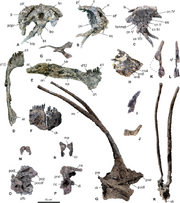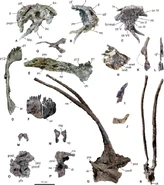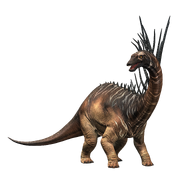| Bajadasaurus Temporal range: Early Cretaceous | |
|---|---|

| |
| Artist illustration of Bajadasaurus pronuspinax | |
| Scientific classification | |
| Kingdom: | Animalia |
| Phylum: | Chordata |
| clade: | †Diplodocoidea |
| Order: | †Saurischia |
| Suborder: | †Sauropodomorpha |
| Family: | †Dicraeosauridae |
| Genus: | †Bajadasaurus Gallina et al., 2019 |
| Species: | †B. pronuspinax |
| Binomial name | |
| Bajadasaurus pronuspinax Gallina et al., 2019 | |
Bajadasaurus ("downhill lizard") is a genus of sauropod from the Early Cretaceous Bajada Colorada Formation of Argentina. Bajadasaurus is distinct due to the extremely long neural spines, similar to those of its close relative Amargasaurus, that extend from its neck vertebrae. These spines curved forward over the animal's neck, resulting in the dinosaur's species name, pronuspinax, meaning "forward curving spine."
Description[]
Bajadasaurus pronuspinax gen. et sp. nov., from Patagonia which preserves the most complete skull of the group and has extremely elongate bifid cervical neural spines that point permanently forward, irrespective of the neck position. Although much shorter versions of this neural spine configuration were already recorded for other dicraeosaurid taxa, the long, anteriorly bent spines of this new dinosaur support the hypothesis that these elongate spines of dicraeosaurid sauropods served as passive defense structures.
Bajadasaurus pronuspinax gen. et sp. nov., from the Early Lower Cretaceous Bajada Colorada Formation (Northern Patagonia, Argentina), which includes dermal roof and palatal bones, a braincase, and a nearly complete lower jaw, expands the knowledge on the skull morphology of this group13. The preserved skull elements including the complete lower jaw allow the first reliable inference of the size and shape of a dicraeosaurid skull. Additionally, the skull was recovered in articulation with the anterior region of the neck and another cervical vertebra with exceptional development of anteriorly bent, bifid cervical neural spines, which informs hypotheses of defense behavior in sauropod dinosaurs. The temporal difference between Bajadasaurus and Amargasaurus, a 15 My younger spiny sauropod from the Neuquén basin, supports that the development of a fence of spines was likely adaptive over a long time period.
Bajadasaurus was recovered from the Bajada formation, a geological formation in the Mendoza group which is exposed in Northern Pangea. This formation is composed of red, green-brown sandstones, and conglomerates of fine to coarse grain size together with bands of reddish claystones and light brown siltstones, these sediments were mostly deposited by braided rivers, as is evident by well-preserved river channels with cross bedding. Paleosols are also present in the formation.

Holotype of Bajadasaurus pronuspinax.
The Bajada Colorada Formation overlies the Quintuco and Picún Leufú Formations, it is separated from the overlying Agrio Formation by an unconformity (sedimentation hiatus) at its top. Bajadasaurus stems from the Bajada Colorada locality, the type locality of the formation. The locality yielded the remains of another sauropod, the diplodocid Leinkupal laticauda, as well as those of several unknown theropod species that can be ascribed to basal Tetanurae and possibly to abelisauroids and deinonychosaurians.
References[]
- https://www.nature.com/articles/s41598-018-37943-3
- https://evrimagaci.org/mohawk-boynuzlu-dinozor-bajadasaurus-7595
- https://www.researchgate.net/figure/Phylogenetic-position-of-Bajadasaurus-pronuspinax-gen-et-sp-nov-MMCh-PV-75-within_fig3_330860223
- https://blog.everythingdinosaur.co.uk/blog/_archives/2019/02/07/defensive-dicraeosaurids-forward-facing-spikes-deter-predators.html
- https://www.thesciencebreaker.org/tags/Bajadasaurus
- https://www.arkeolojikhaber.com/haber-dikenli-dinozor-bajadasaurus-pronuspinaxin-boynu-muzede-sergileniyor-19620/
- https://www.theatlantic.com/science/archive/2019/02/dinosaur-bajadasaurus-had-mohawk-horns/582055/
- https://www.mindat.org/taxon-P381350.html
- https://www.nature.com/articles/s41598-018-37943-3/figures/2
In Popular Culture[]
- Bajadasaurus appears as one of many collectible prehistoric creatures in the video game Jurassic World: Alive. It is currently the most recently described genus to appear in the franchise.






